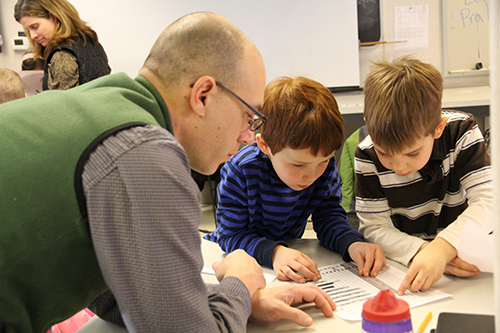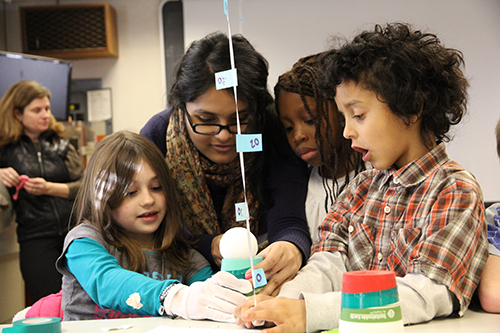X-RAY RUNS: Apply for Beamtime
2017 Nov 1 - Dec 21
2018 Feb 7 - Apr 3
2018 Proposal/BTR deadline: 12/1/17
2018 Apr 11 - Jun 4
2018 Proposal/BTR deadline: 2/1/18
Imagine walking into a room full of young school children huddled around tables with an adult
volunteer, Styrofoam balls being flung intentionally into the air, and students delightedly
observing, measuring and recording their results. Self-made tape measurers hang suspended from
the ceiling, stretched to reach the tops of the tables with 10cm increments clearly marked.
Kids take turns vertically propelling the balls using student-made ball-launchers. This was the
scene in the eXploration station this past month when first graders from Fall Creek Elementary
School participated in bimonthly visits to Xraise at Cornell during the past school year.
Teachers Chris Bell and Abigail Bokaer brought their students, sometimes riding the bus and
sometime walking up the hill, to participate in these science investigations.

Parent volunteer Josh Giblin helps the first graders visualize the results of their data collection by creating a bar graph.
Students, after creating their own ball launchers by cutting out the bottom of a
paper cup, stretching a balloon across the opening, and using colorful tape to hold the balloon
in place, pull back the loose end of the balloon and launch their Styrofoam ball vertically into
the air. "Wow! Did you see that?" "Oh yeah!" and other expressions of enthusiasm could be heard
throughout the room. "The children love the visits to the eXploration station," says first grade
teacher Chris Bell. "The kids are excited about science and learning through hands-on activities.
The parent volunteers rave about the field trips and are thrilled that their kids are going on
them each month.

Cornell physics undergraduate student Pratiti Deb works with a small group of students getting ready to launch their projectile.
All of the first graders are engaged in the activity, testing one variable at a
time; the distance in cm that the loose balloon material is stretched. After stretching the
balloon a set distance, varied with each trial, the students measure the vertical height of their
projectile, clapping when the greatest height is achieved. Students then graph the different
length of stretched balloon material versus the height of the projectile. Students notice a
trend — the greater the distance the elastic material is pulled, the greater the height of the
projectile. This lesson, an exploration of elastic potential energy, was just one of the many
activities that students participated in during their visits to the eXploration station.
Submitted by: Lora Hine, Cornell University
06/04/2014
